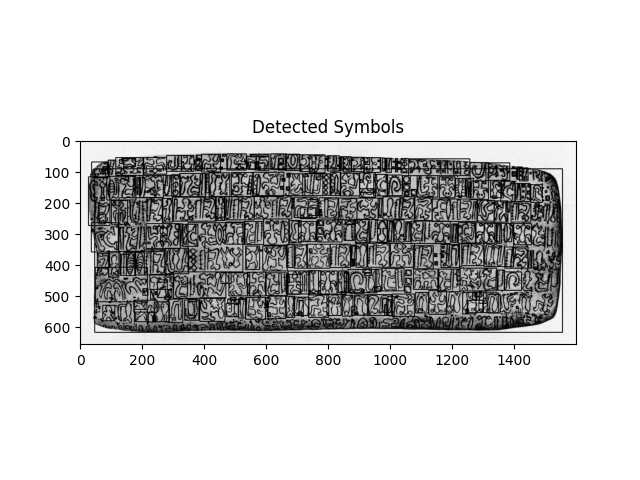Exploring the Rongorongo Script: A Technical Analysis
#
Introduction
The Rongorongo script, found on Easter Island, has puzzled researchers for decades. With its intricate glyphs and undeciphered nature, it has been compared to other ancient writing systems like the Indus Valley Script, Egyptian hieroglyphs, and the Andean quipu. In our research, we applied modern image processing and clustering techniques to analyze a tablet containing Rongorongo symbols, aiming to identify patterns and relationships among the glyphs.
Podcast
Methods
Using Python, OpenCV, and scikit-learn, we processed images of the Rongorongo tablet to identify unique symbols and analyze their distribution. The process included:
- Image Preprocessing: Conversion of the tablet image to grayscale, thresholding, and contour detection to isolate each symbol.
- Feature Extraction: Resizing and flattening each detected symbol into a vector for clustering.
- Clustering Analysis: Using the DBSCAN algorithm, we identified 13 unique symbols in the text, visualizing their relationships through t-SNE (t-Distributed Stochastic Neighbor Embedding).
Results
The analysis revealed several key insights:
- 13 Unique Symbols Detected: Despite the complex appearance of the text, our analysis identified a core set of 13 unique symbols. This suggests that Rongorongo may use a limited set of repeating glyphs, potentially as a proto-writing system or mnemonic aid.
- Distinct Symbol Clusters: The t-SNE visualization (see Figure 1) shows clear clusters, indicating that certain symbols have a consistent shape and appear frequently. This could mean that these symbols play a central role in the script, possibly representing key concepts or actions.
- Outliers and Variability: Symbols classified as noise or outliers might represent rare symbols or variations in the text, adding depth to our understanding of how the script might encode unique or context-specific information.
Figure 1: t-SNE Visualization of Detected Symbols
Figure 2: Detected Symbols on the Tablet
The following image shows the detected symbols outlined on the original Rongorongo tablet. This visualization highlights the contours identified during the preprocessing stage. 
Hypotheses and Conjectures
From the results of our analysis, we propose several hypotheses regarding the nature of the Rongorongo script:
- Proto-Writing System: With only 13 unique symbols, it is likely that Rongorongo functions more as a proto-writing system rather than a fully developed language. Symbols may represent whole ideas or concepts rather than phonetic components.
- Ritualistic or Mnemonic Use: The consistent appearance of certain symbols suggests they could serve as mnemonic aids, used in rituals or storytelling. This is reminiscent of how Andean quipu used knots to record information.
- Logographic Elements: The strong clustering of specific symbols may indicate a logographic nature, where each symbol represents an entire word or concept. This is similar to systems like Egyptian hieroglyphs or early Chinese script.
- Symbolic Variations and Stages: The outliers in the t-SNE plot might represent variations of core symbols, potentially used to encode stages of a journey or phases of a ritual, aligning with cultural practices of recording progression or transformation.
Conclusion
While our research does not fully decipher the Rongorongo script, it provides a framework for understanding its structural characteristics. The use of modern image processing and clustering techniques allows us to identify patterns that could guide future studies. This analysis opens the door for a deeper exploration of how these ancient symbols might encode the cultural heritage of the Rapa Nui people.
Our findings suggest that the Rongorongo script could hold clues to an ancient method of recording knowledge, blending elements of proto-writing, mnemonic devices, and logographic symbolism. Further research could focus on cross-referencing our detected symbols with known elements from Polynesian oral traditions or other undeciphered scripts.
References
- Barthel, Thomas S. (1978). The Decipherment of the Rongorongo Script of Easter Island.
- Fischer, Steven Roger. (1997). Glyphbreaker. An analysis of various attempts to decode the script.
- Image Processing and Symbol Detection performed using Python libraries:
OpenCV,scikit-learn,matplotlib.
Acknowledgments
We thank the open-source community for tools like Python, which made this analysis possible, and the researchers who continue to study the enigmatic Rongorongo script.

